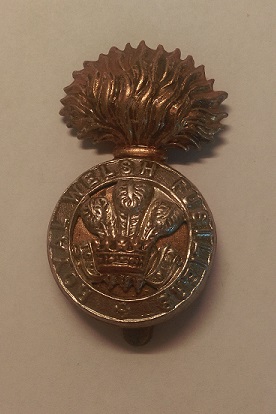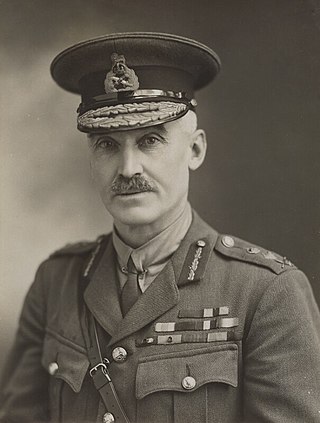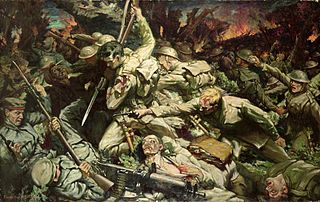
Walter David Jones CH was a British painter and modernist poet. As a painter he worked mainly in watercolour on portraits and animal, landscape, legendary and religious subjects. He was also a wood-engraver and inscription painter. In 1965, Kenneth Clark took him to be the best living British painter, while both T. S. Eliot and W. H. Auden put his poetry among the best written in their century. Jones's work gains form from his Christian faith and Welsh heritage.

The Royal Welch Fusiliers (Welsh: Ffiwsilwyr Brenhinol Cymreig) was a line infantry regiment of the British Army, and part of the Prince of Wales's Division, that was founded in 1689; shortly after the Glorious Revolution. In 1702, it was designated a fusilier regiment and became the Welch Regiment of Fusiliers; the prefix "Royal" was added in 1713, then confirmed in 1714 when George I named it the Prince of Wales's Own Royal Regiment of Welsh Fusiliers. In 1751, after reforms that standardised the naming and numbering of regiments, it became the 23rd Regiment of Foot (Royal Welsh Fuzileers). In 1881, the final title of the regiment was adopted.
The 36th (Ulster) Division was an infantry division of the British Army, part of Lord Kitchener's New Army, formed in September 1914. Originally called the Ulster Division, it was made up of mainly members of the Ulster Volunteer Force, who formed thirteen additional battalions for three existing regiments: the Royal Irish Fusiliers, the Royal Irish Rifles and the Royal Inniskilling Fusiliers. The division served from October 1915 on Western Front as a formation of the British Army during the Great War.

The 16th (Irish) Division was an infantry division of the British Army, raised for service during World War I. The division was a voluntary 'Service' formation of Lord Kitchener's New Armies, created in Ireland from the 'National Volunteers', initially in September 1914, after the outbreak of the Great War. In December 1915, the division moved to France, joining the British Expeditionary Force (BEF), under the command of Irish Major General William Hickie, and spent the duration of the war in action on the Western Front. Following enormous losses at the Somme, Passchendaele and Ypres, the 16th (Irish) Division required a substantial refit in England between June and August 1918, which involved the introduction of many non-Irish battalions.

The 38th (Welsh) Division of the British Army was active during both the First and Second World Wars. In 1914, the division was raised as the 43rd Division of Herbert Kitchener's New Army, and was originally intended to form part of a 50,000-strong Welsh Army Corps that had been championed by David Lloyd George; the assignment of Welsh recruits to other formations meant that this concept was never realised.

The Battle of Albert is the British name for the first two weeks of British–French offensive operations of the Battle of the Somme. The Allied preparatory artillery bombardment commenced on 24 June and the British–French infantry attacked on 1 July, on the south bank from Foucaucourt to the Somme and from the Somme north to Gommecourt, 2 mi (3.2 km) beyond Serre. The French Sixth Army and the right wing of the British Fourth Army inflicted a considerable defeat on the German 2nd Army but from near the Albert–Bapaume road to Gommecourt, the British attack was a disaster, where most of the c. 57,000 British casualties of the day were incurred. Against the wishes of General Joseph Joffre, General Sir Douglas Haig abandoned the offensive north of the road to reinforce the success in the south, where the British–French forces pressed forward through several intermediate lines closer to the German second position.

General Henry Sinclair Horne, 1st Baron Horne, was a military officer in the British Army, most notable for his generalship during the First World War, where he commanded at division, corps, and field army level, rising to command the British First Army in 1916, which he held until the armistice of 11 November 1918. He was the only British artillery officer to command an army in the war.
This article is about the particular significance of the year 1916 to Wales and its people.

In Parenthesis is a work of literature by David Jones first published in England in 1937. Although Jones had been known solely as an engraver and painter prior to its publication, the book won the Hawthornden Prize and the admiration of writers such as W. B. Yeats and T. S. Eliot. Based on Jones's own experience as an infantryman in the First World War, In Parenthesis narrates the experiences of English private John Ball in a mixed English-Welsh regiment, starting with embarkation from England and ending seven months later with the assault on Mametz Wood during the Battle of the Somme. The work employs a mixture of lyrical verse and prose, is highly allusive, and ranges in tone from formal to Cockney colloquial and military slang.

Mametz is a former commune in the Somme department in Hauts-de-France in northern France. On 1 January 2019, it was merged into the new commune Carnoy-Mametz.

The 115th Brigade was an infantry brigade of the British Army raised for 38th (Welsh) Division during both the First and Second World Wars.

The Capture of Mametz took place on 1 July 1916, when the British Fourth Army attacked the German 2nd Army on the Western Front, during the first day of the Battle of the Somme. Mametz is a village on the D 64 road, about 20 mi (32 km) north-east of Amiens and 4 mi (6.4 km) east of Albert. Fricourt lies to the west, Contalmaison is to the north, Montauban to the north-east and Carnoy and Maricourt are to the south-east. Mametz Wood is 1,000 yd (910 m) to the north-west and before 1914, the village was the fifth largest in the area, with about 120 houses and had a station on the line from Albert to Péronne. During the Battle of Albert the II Bavarian Corps attacked westwards north of the Somme but was fought to a standstill east of Mametz. Reinforced by the XIV Reserve Corps the Germans on the north side of the Somme attacked again and took Mametz on 29 September. After a mutually costly battle for Fricourt, where the French were eventually forced out, the front line stabilised and both sides began to improvise defences. In mid-December a French local attack in the Mametz area was a costly failure.

The Welsh National Memorial Park is a war memorial in Langemark near Ypres (Belgium) for soldiers of World War I, located near the Pilkem Ridge in the former Ypres Salient. It commemorates the service of men and women of Welsh origin, wherever they served during the Great War as part of the Allied Powers, as well as the non-Welsh soldiers serving in Welsh formations.

The Capture of Contalmaison was a tactical incident of the Battle of Albert. Contalmaison is a commune in the Somme department in Picardy in northern France. The village is 4 mi (6.4 km) north-east of Albert on the D 104, north-west of Mametz Wood and south of Pozières, at the junction of several roads, atop a spur with a good view in all directions. In 1914, there was a church and a château just to the north, a chalk pit nearby and 72 houses, making it the seventh-largest village on the Somme. Military operations in the area began when the German XIV Reserve Corps advanced down the Bapaume–Albert road and Contalmaison was captured at noon on 28 September, by Reserve Infantry Regiment 40 and RIR 110 of the 28th Reserve Division which took 20 prisoners for a loss of three men killed and 21 wounded.

Dantzig Alley British Cemetery is a Commonwealth War Graves Commission burial ground for the dead of the First World War. It is located near the village of Mametz, eight kilometres from Albert in the Somme department of France.

The Welsh at Mametz Wood by Christopher Williams portrays the 11 July 1916 Charge of the Welsh Division at Mametz Wood, part of the Somme offensive. Painted at the request of the Secretary of State for War, David Lloyd George. Williams visited the scene in November 1916 and later made studies from a soldier supplied for the purpose. The painting is in the collection of the National Museum of Wales, to whom it was presented by Sir Archibald Mitchelson in 1920.

Wales, as part of the United Kingdom, participated as part of the allies in World War I (1914–1918) and the allies in World War II (1939–1945).

The 2nd Gwent Battalion was a Welsh 'Pals battalion' formed as part of 'Kitchener's Army' during World War I. Raised by local initiative in Monmouthshire and Brecknockshire, it became the 11th (Service) Battalion of the local regiment, the South Wales Borderers. It served in 38th (Welsh) Division and led the division's costly attack on Mametz Wood during the Battle of the Somme. The battalion continued to serve on the Western Front, including the Third Battle of Ypres. It was disbanded early in 1918, but many of its personnel remained together for a few weeks in a composite battalion that saw action at the Battle of Estaires in April 1918.

The 1st Gwent Battalion was a Welsh 'Pals battalion' formed as part of 'Kitchener's Army' during World War I. Raised by local initiative in Monmouthshire and Glamorgan, it became the 10th (Service) Battalion of the local regiment, the South Wales Borderers. It served in 38th (Welsh) Division and took part in the division's costly attack on Mametz Wood during the Battle of the Somme. The battalion continued to serve on the Western Front, including the Third Battle of Ypres and the final Hundred Days Offensive.















